
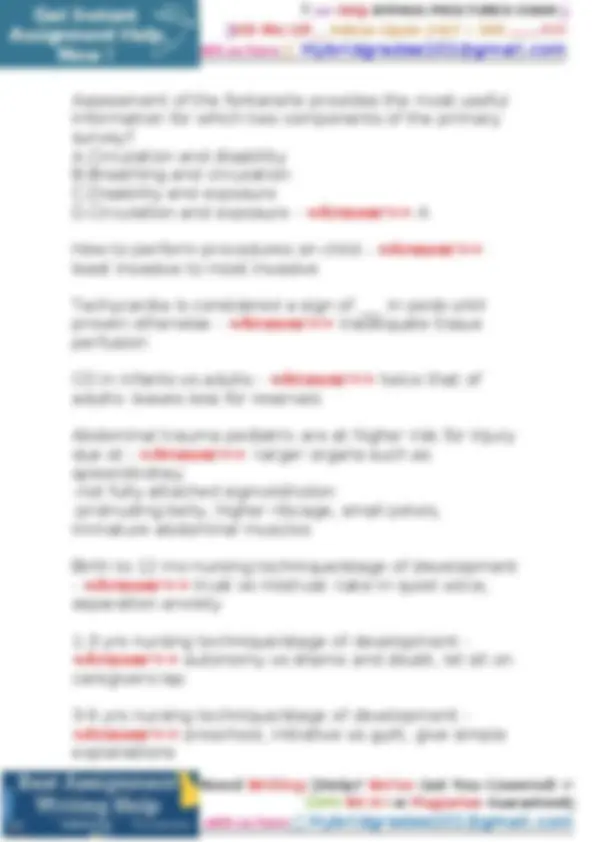
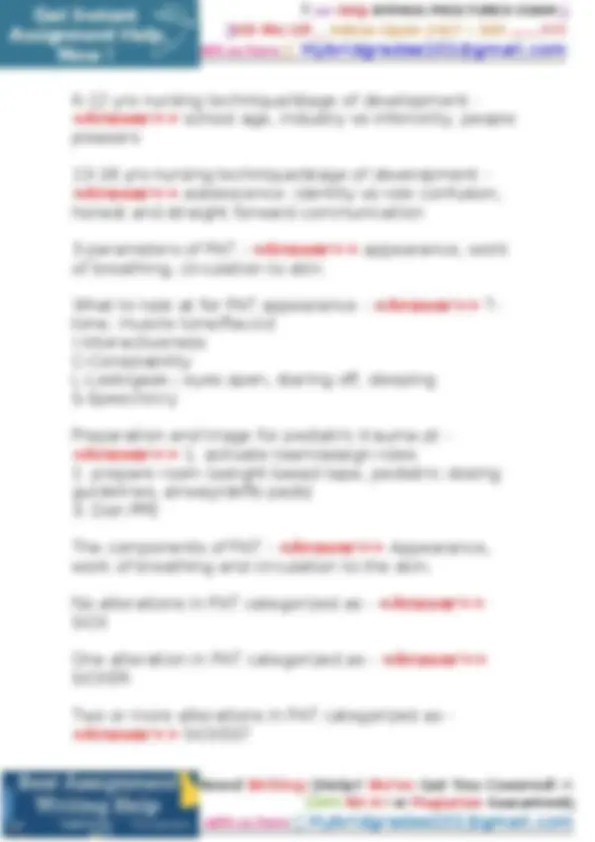
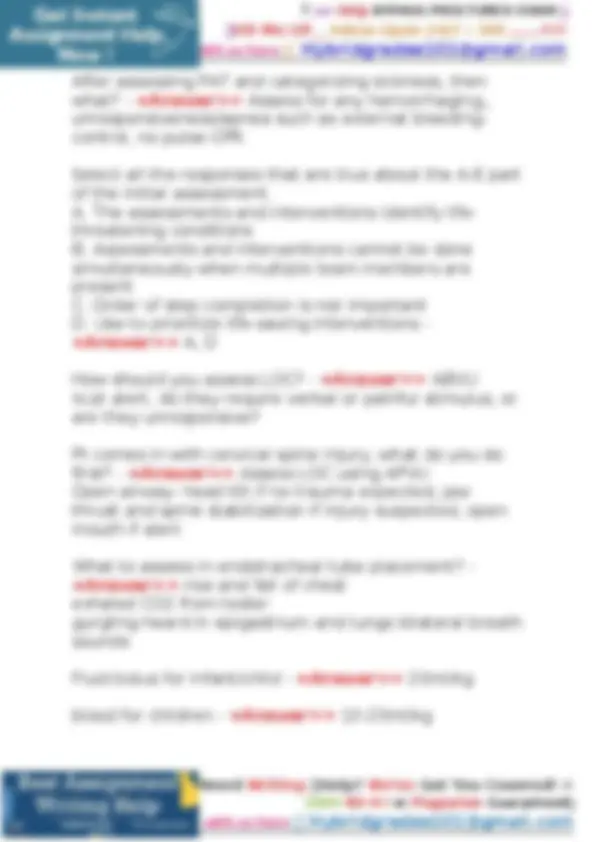
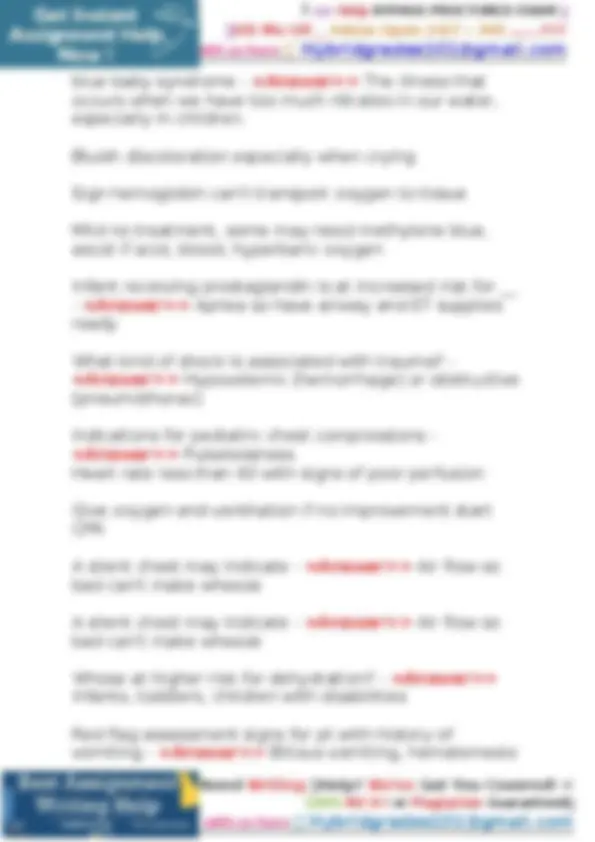
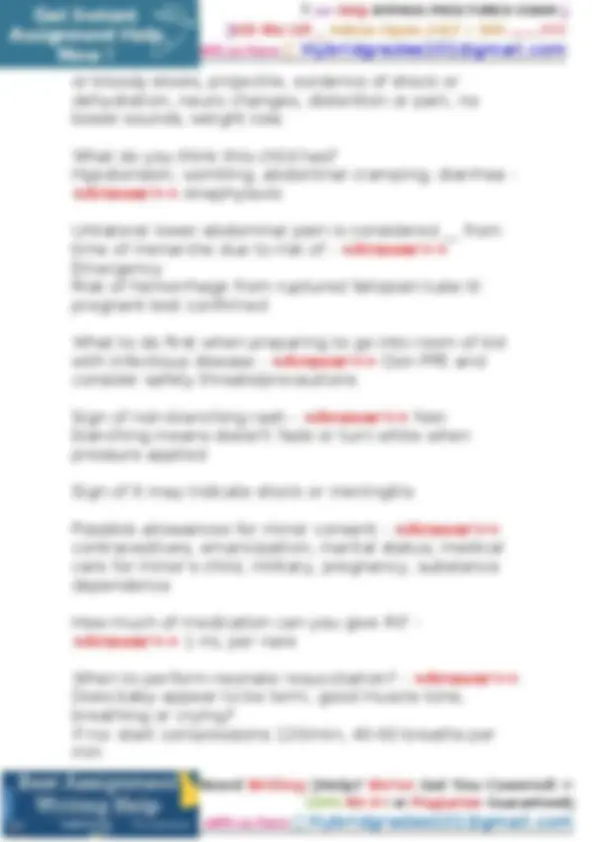
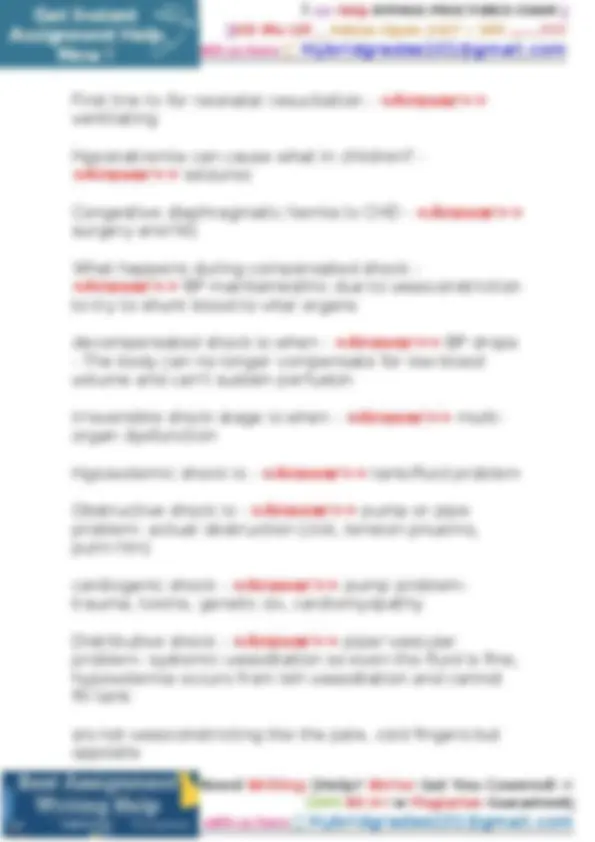
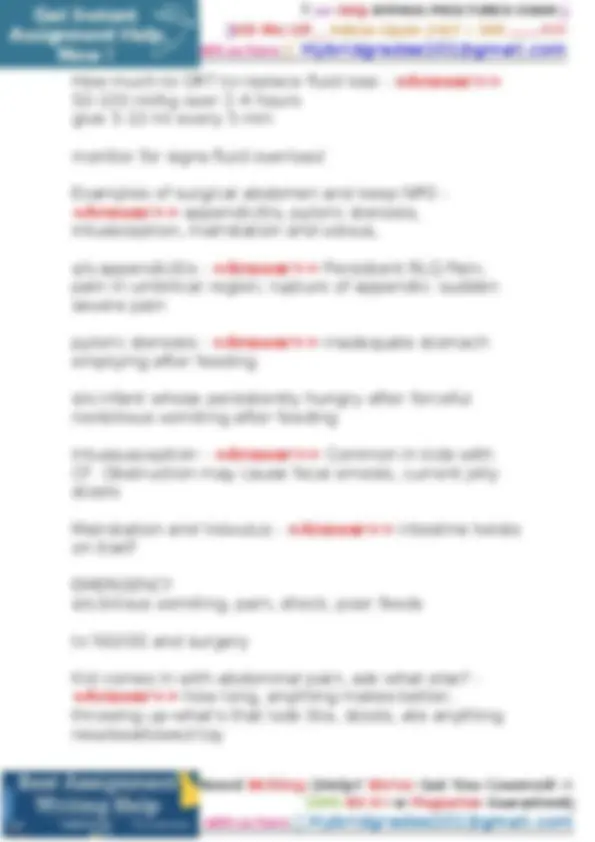
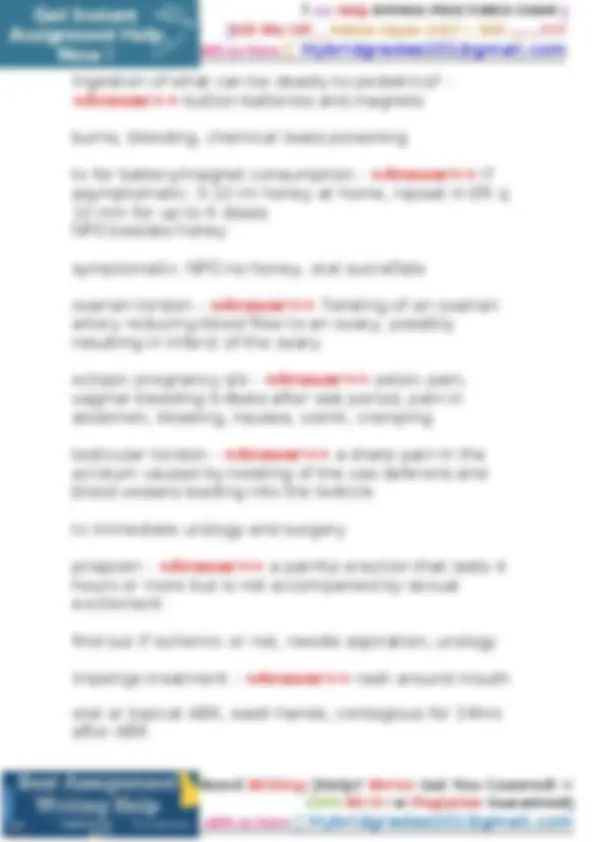
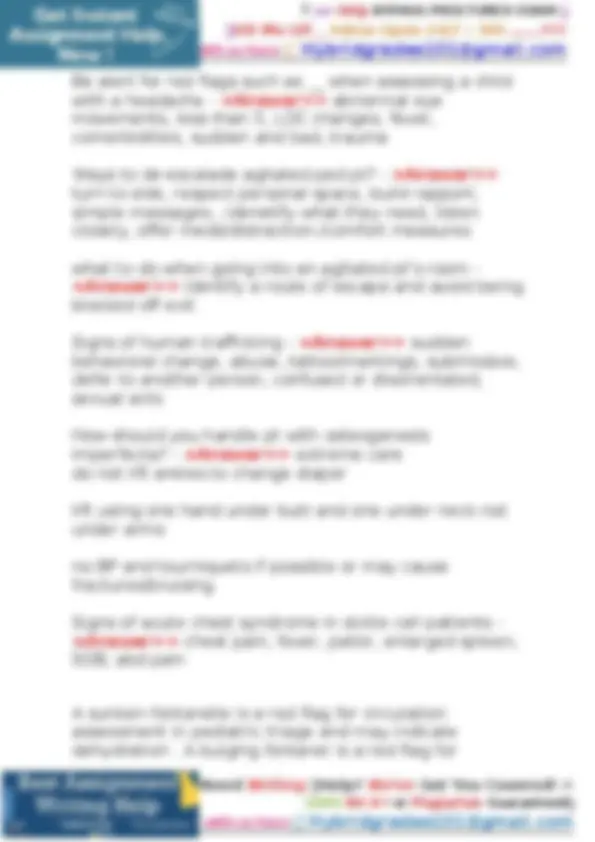
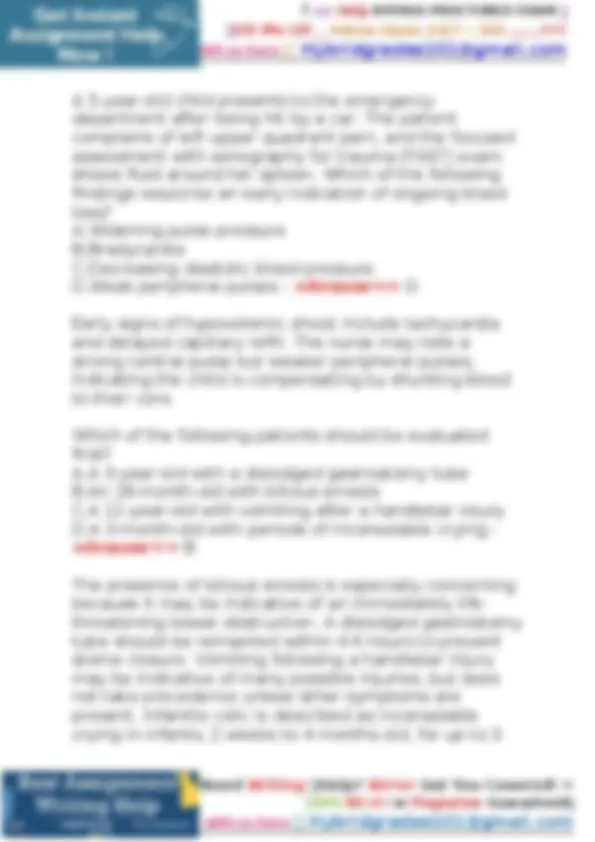
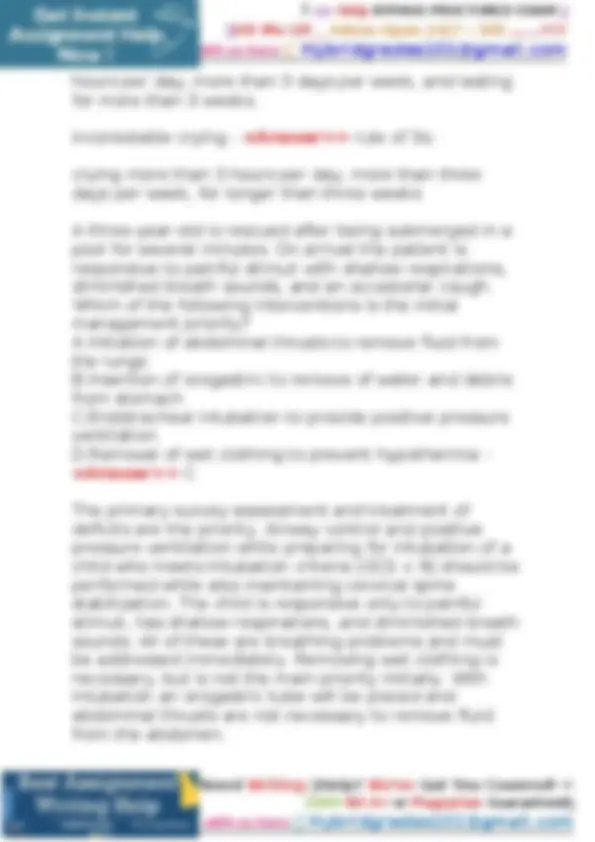


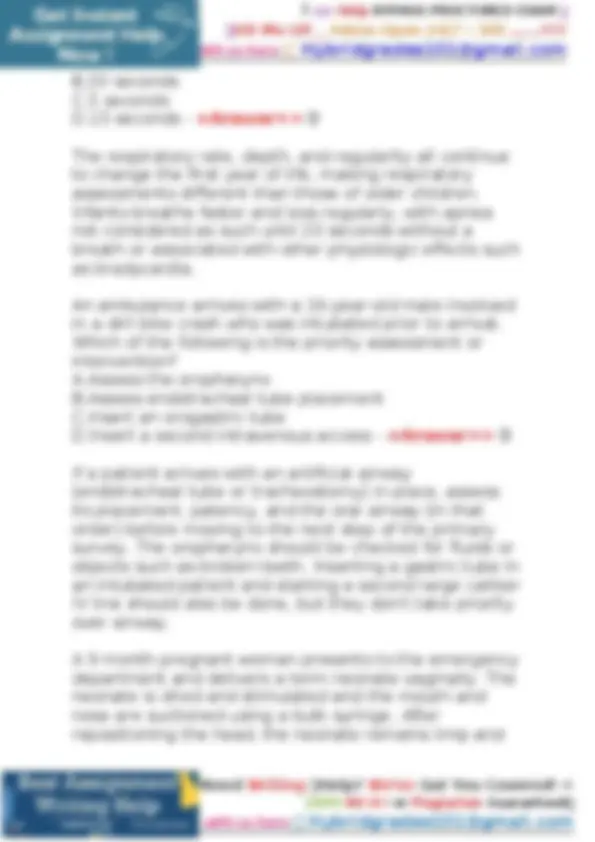
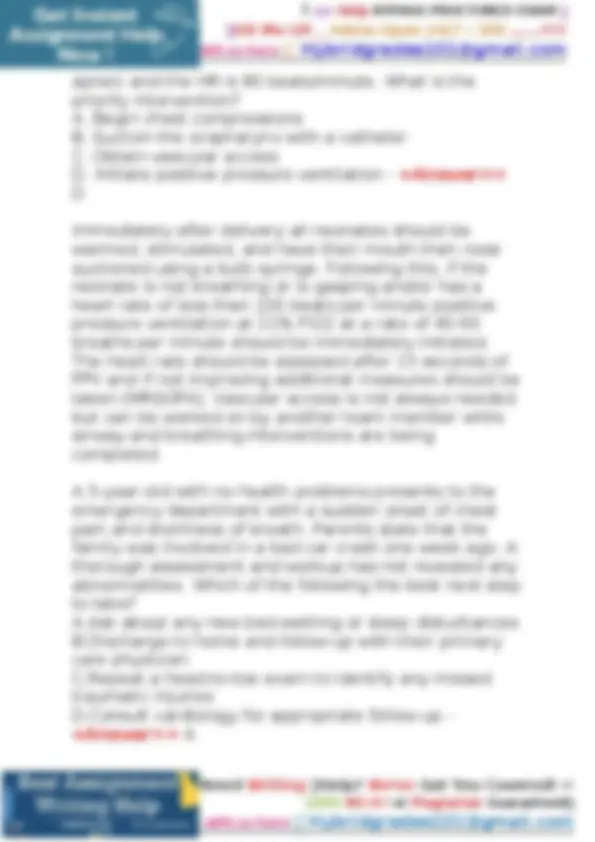
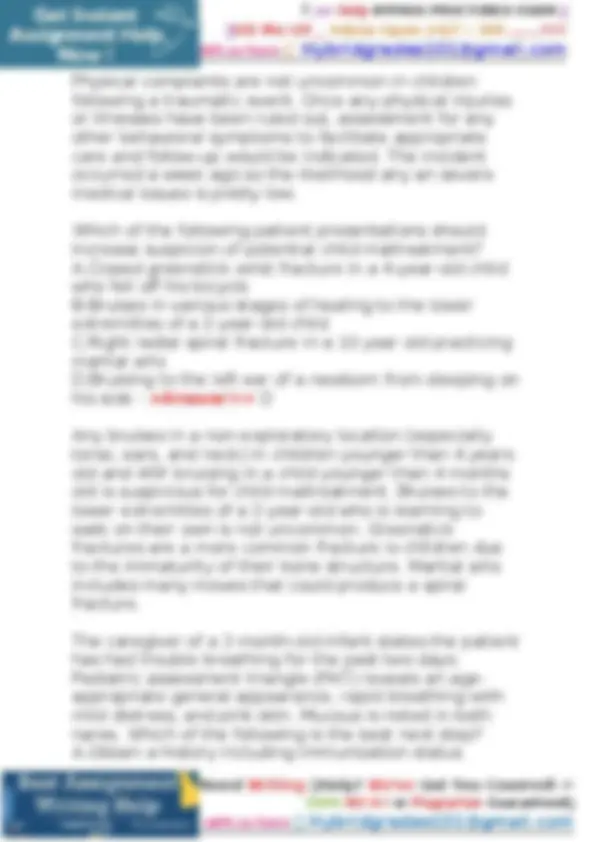
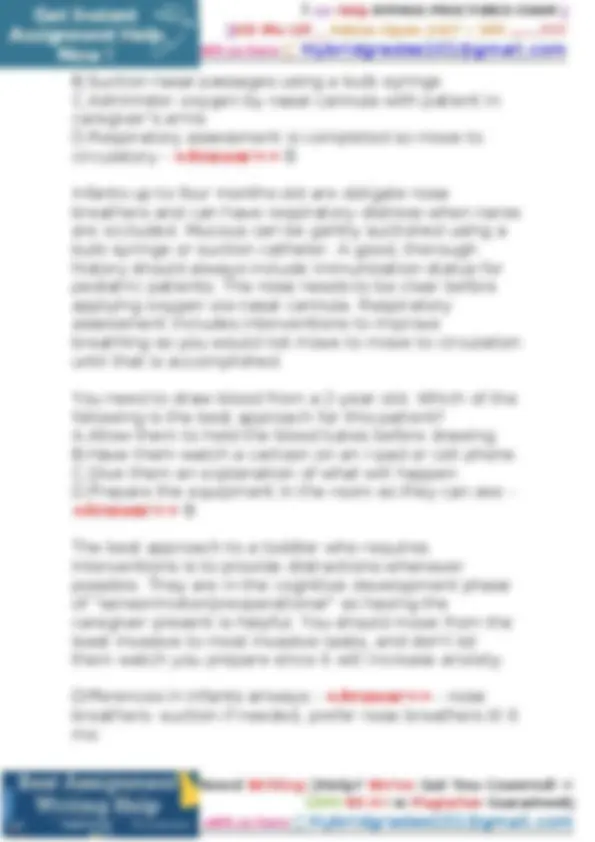

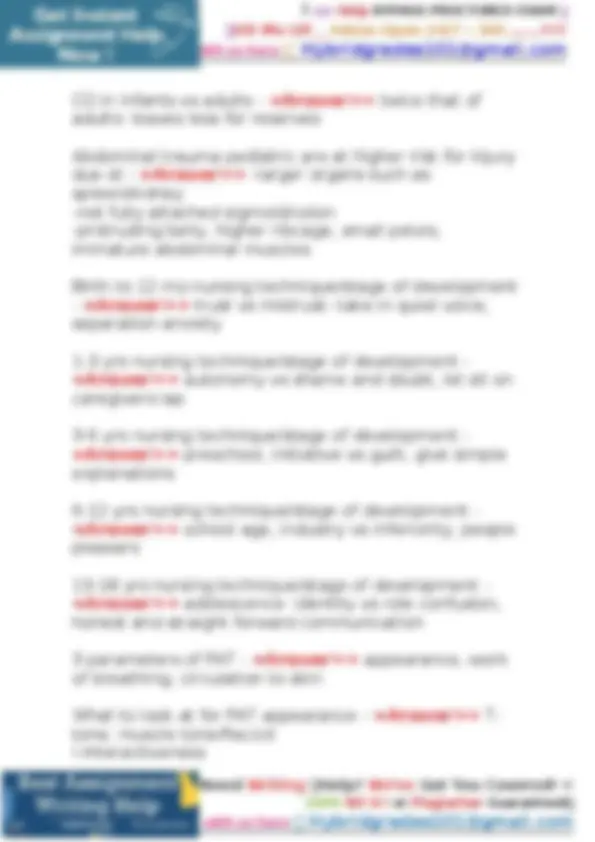
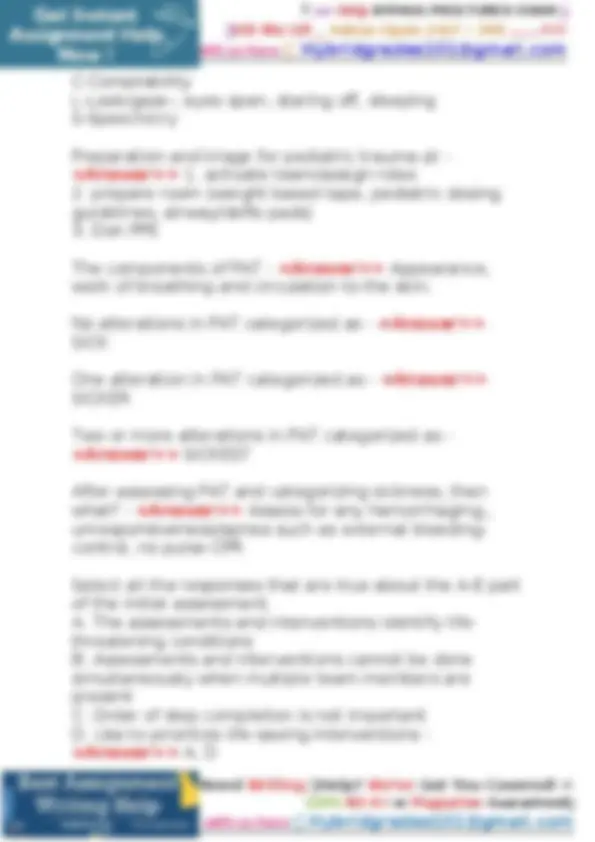
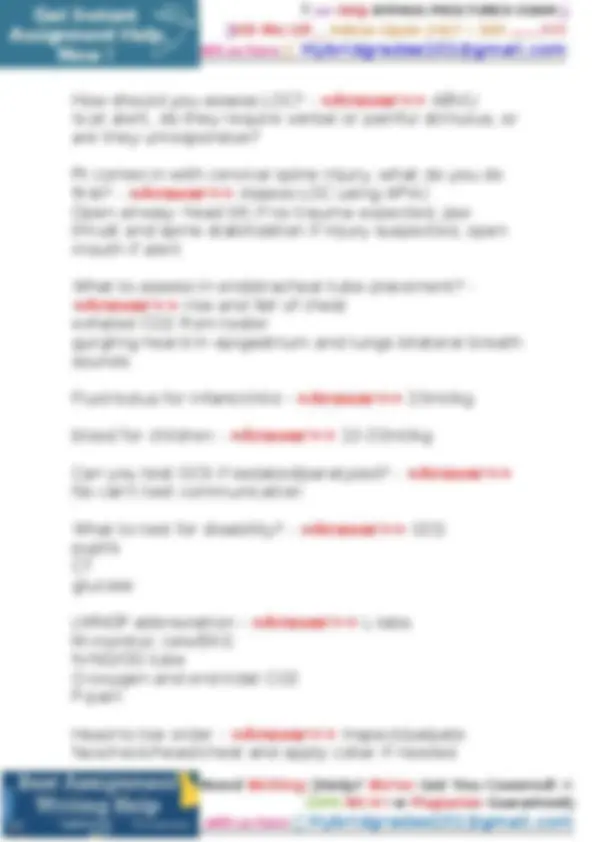
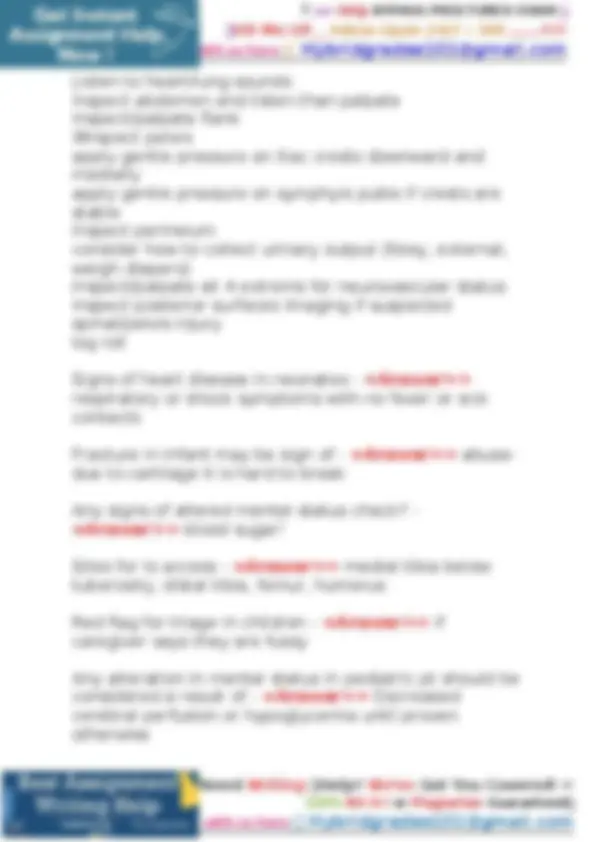
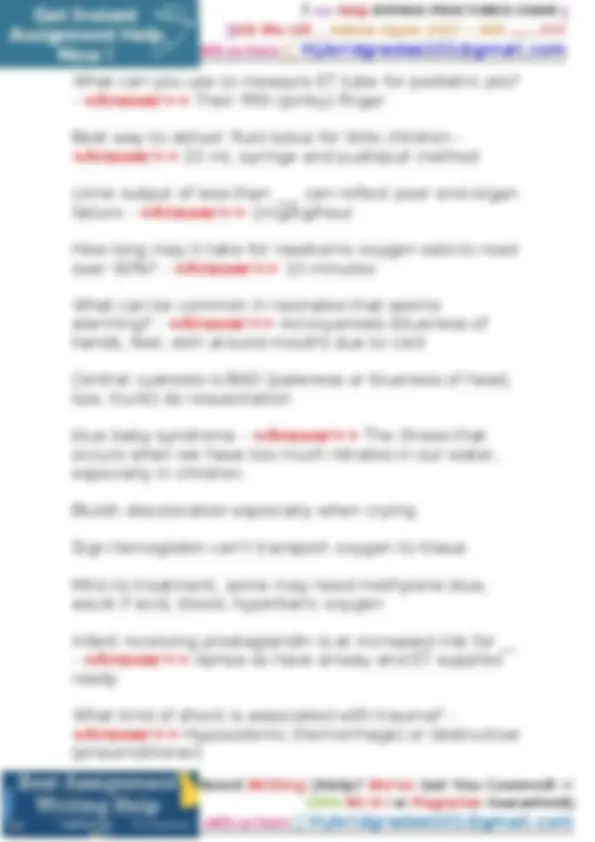
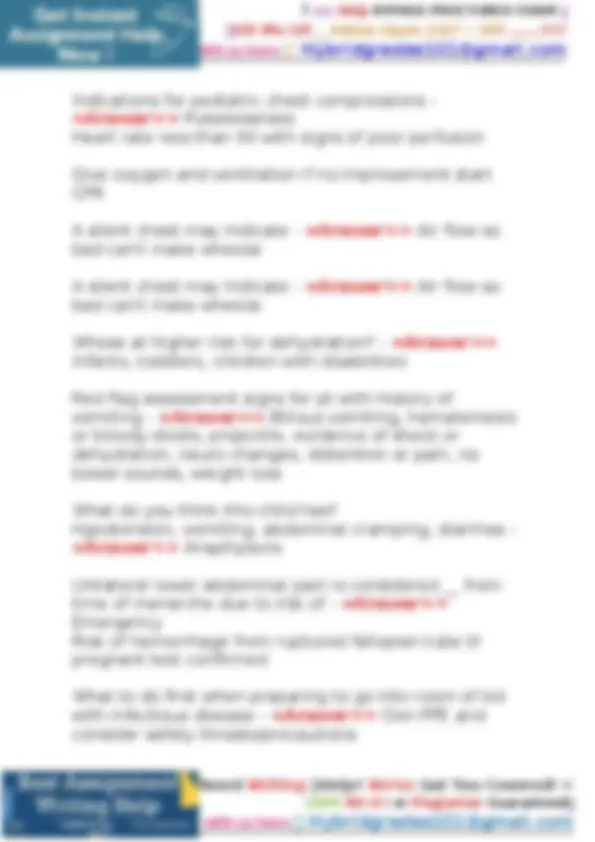

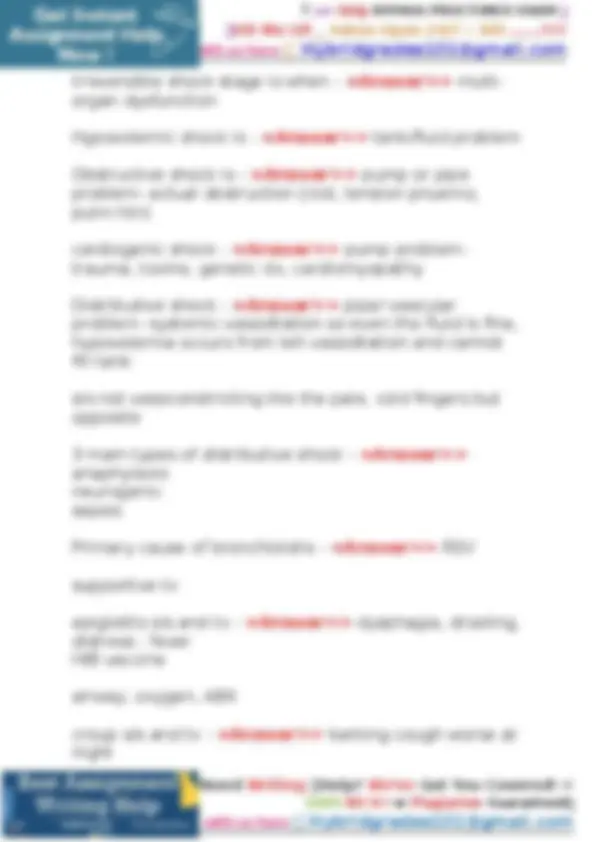

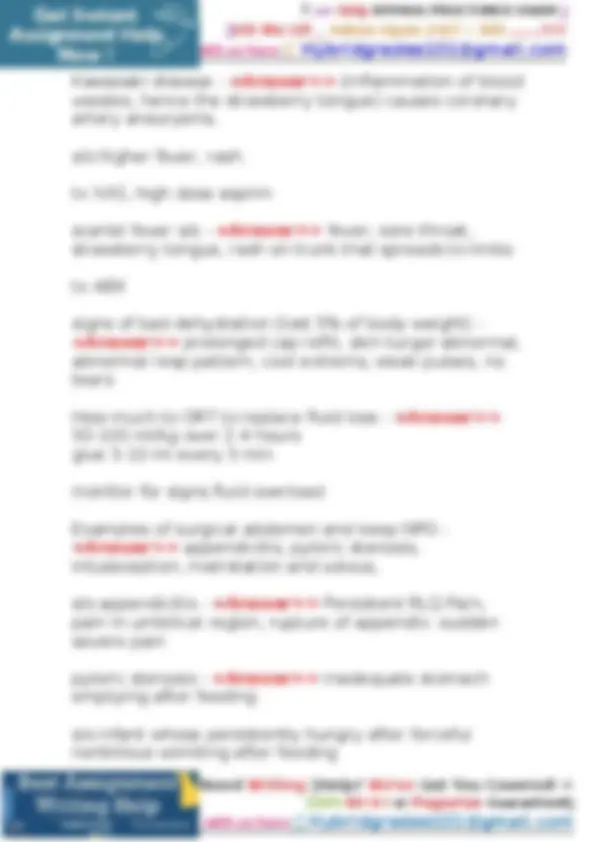
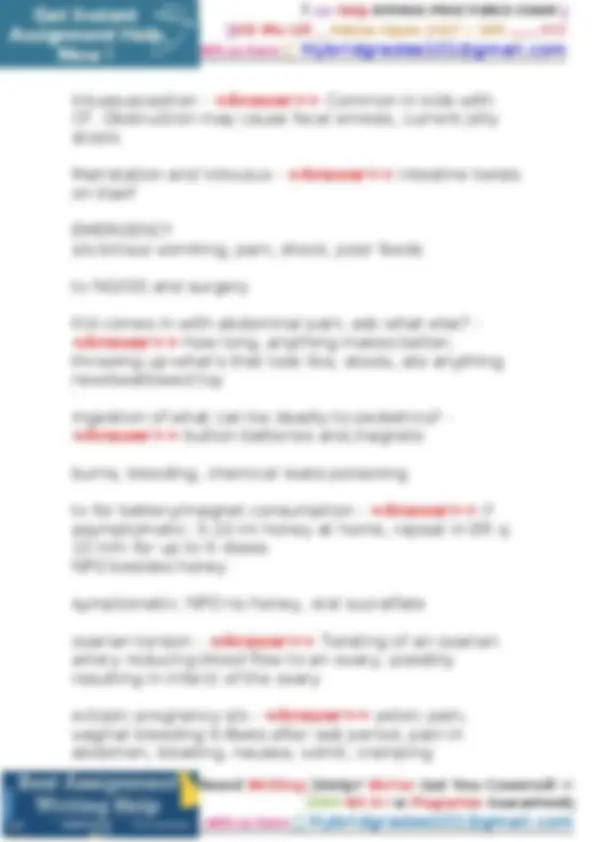
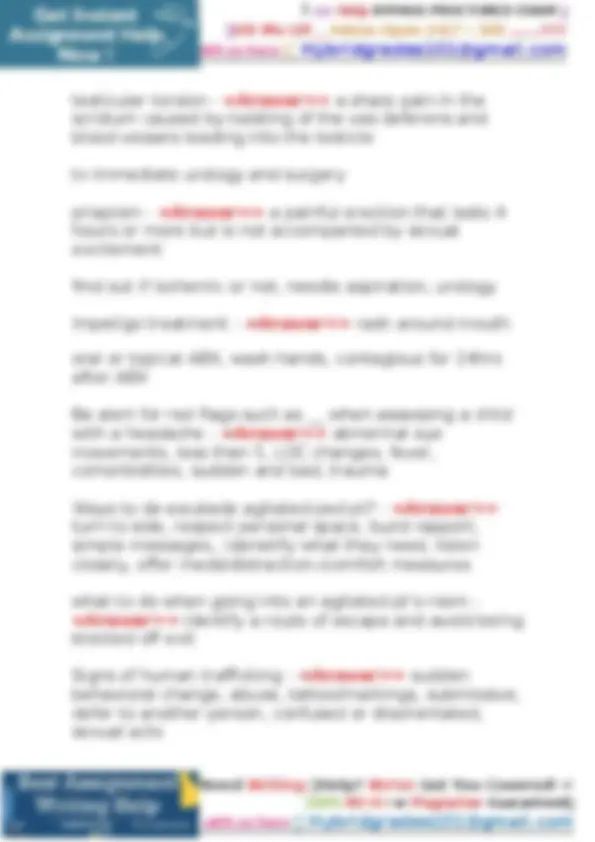



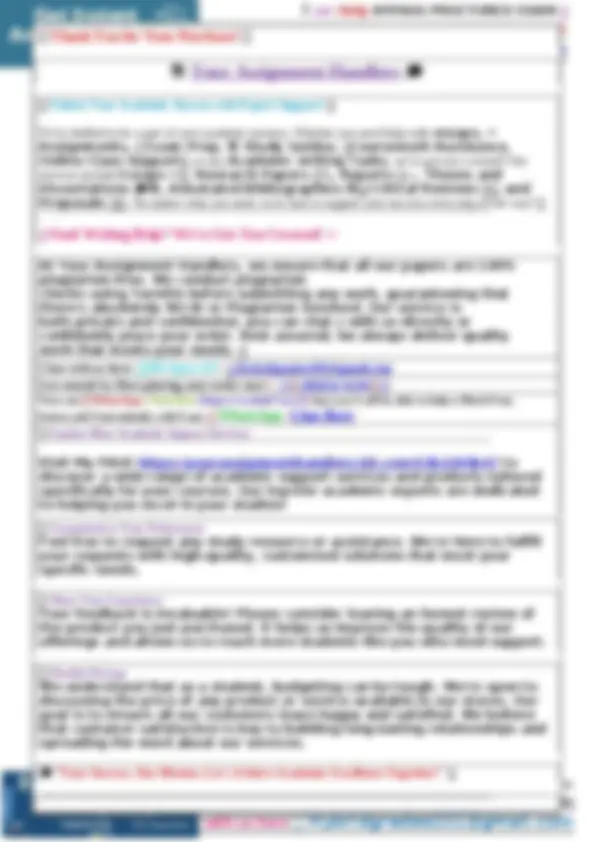



Study with the several resources on Docsity

Earn points by helping other students or get them with a premium plan


Prepare for your exams
Study with the several resources on Docsity

Earn points to download
Earn points by helping other students or get them with a premium plan
Community
Ask the community for help and clear up your study doubts
Discover the best universities in your country according to Docsity users
Free resources
Download our free guides on studying techniques, anxiety management strategies, and thesis advice from Docsity tutors
A comprehensive set of questions and answers related to the enpc (emergency nursing pediatric course) certification exam. It covers various aspects of pediatric emergency care, including assessment, management, and treatment of common pediatric emergencies. Designed to help students prepare for the enpc certification exam and enhance their understanding of pediatric emergency nursing principles.
Typology: Exams
1 / 43

This page cannot be seen from the preview
Don't miss anything!




































Course Title and Number: ATLS Written Examination & Practical Skills Assessment Exam Title: ATLS Exam Exam Date: Exam 2025- 2026 Instructor: ____ [Insert Instructor’s Name] _______ Student Name: ___ [Insert Student’s Name] _____ Student ID: ____ [Insert Student ID] _____________
Time: - ____ Hours: ___ Minutes
📱Hit Me UP__ Inbox Open 24/7 – 365 …...!!!! 📱 Chat with us here : 📱 Hybridgrades101@gmail.com
Read All Instructions Carefully and Answer All the Questions Correctly Good Luck: - A 4-day-old who is brought to the emergency department with the parental complaint of "not acting right" is found to be hypoglycemic. What is the appropriate glucose concentration to administer to this neonate? A.Dextrose 5% B.Dextrose 10% C.Dextrose 25% D.Dextrose 50% - =Answer>> B Dextrose 10% is the preferred concentration for neonates with hypoglycemia to protect their fragile vasculature while providing needed glucose. Dextrose 5% is not used to treat hypoglycemia in children. Dextrose 25% is used for children above the age of 5 years. Dextrose 50% is not recommended for use in pediatrics unless it is diluted. Need Writing 📱Help? We've Got You Covered! ✍ 100% NO A I or Plagiarism Guaranteed📱 Click Here To <
NOW.!!!
📱Hit Me UP__ Inbox Open 24/7 – 365 …...!!!! 📱 Chat with us here : 📱 Hybridgrades101@gmail.com 6-12 yrs nursing technique/stage of development - =Answer>> school age, industry vs inferiority, people pleasers 13-18 yrs nursing technique/stage of development - =Answer>> adolescence- identity vs role confusion, honest and straight forward communication 3 parameters of PAT - =Answer>> appearance, work of breathing, circulation to skin What to look at for PAT appearance - =Answer>> T- tone; muscle tone/flaccid I-Interactiveness C-Consolability L-Look/gaze-; eyes open, staring off, sleeping S-Speech/cry Preparation and triage for pediatric trauma pt - =Answer>> 1. activate team/assign roles
📱Hit Me UP__ Inbox Open 24/7 – 365 …...!!!! 📱 Chat with us here : 📱 Hybridgrades101@gmail.com After assessing PAT and categorizing sickness, then what? - =Answer>> Assess for any hemorrhaging,, unresponsiveness/apnea such as external bleeding- control, no pulse-CPR Select all the responses that are true about the A-E part of the initial assessment. A. The assessments and interventions identify life- threatening conditions B. Assessments and interventions cannot be done simultaneously when multiple team members are present C. Order of step completion is not important D. Use to prioritize life-saving interventions - =Answer>> A, D How should you assess LOC? - =Answer>> ABVU Is pt alert, do they require verbal or painful stimulus, or are they unresponsive? Pt comes in with cervical spine injury, what do you do first? - =Answer>> Assess LOC using APVU Open airway- head tilt if no trauma expected, jaw thrust and spine stabilization if injury suspected, open mouth if alert What to assess in endotracheal tube placement? - =Answer>> rise and fall of chest exhaled CO2 from tester gurgling heard in epigastrium and lungs bilateral breath sounds Fluid bolus for infant/child - =Answer>> 20ml/kg blood for children - =Answer>> 10-20ml/kg Need Writing 📱Help? We've Got You Covered! ✍ 100% NO A I or Plagiarism Guaranteed📱
📱Hit Me UP__ Inbox Open 24/7 – 365 …...!!!! 📱 Chat with us here : 📱 Hybridgrades101@gmail.com Fracture in infant may be sign of - =Answer>> abuse- due to cartilage it is hard to break Any signs of altered mental status check? - =Answer>> blood sugar! Sites for Io access - =Answer>> medial tibia below tuberosity, distal tibia, femur, humerus Red flag for triage in children - =Answer>> if caregiver says they are fussy Any alteration in mental status in pediatric pt should be considered a result of - =Answer>> Decreased cerebral perfusion or hypoglycemia until proven otherwise What can you use to measure ET tube for pediatric pts?
📱Hit Me UP__ Inbox Open 24/7 – 365 …...!!!! 📱 Chat with us here : 📱 Hybridgrades101@gmail.com blue baby syndrome - =Answer>> The illness that occurs when we have too much nitrates in our water, especially in children. Bluish discoloration especially when crying Sign hemoglobin can't transport oxygen to tissue Mild no treatment, some may need methylene blue, ascot if acid, blood, hyperbaric oxygen Infant receiving prostaglandin is at increased risk for __
📱Hit Me UP__ Inbox Open 24/7 – 365 …...!!!! 📱 Chat with us here : 📱 Hybridgrades101@gmail.com First line tx for neonatal resucitation - =Answer>> ventilating Hyponatremia can cause what in children? - =Answer>> seizures Congestive diaphragmatic hernia tx CHD - =Answer>> surgery and NG What happens during compensated shock - =Answer>> BP maintained/inc due to vasoconstriction to try to shunt blood to vital organs decompensated shock is when - =Answer>> BP drops
📱Hit Me UP__ Inbox Open 24/7 – 365 …...!!!! 📱 Chat with us here : 📱 Hybridgrades101@gmail.com 3 main types of distributive shock - =Answer>> anaphylaxis neurogenic sepsis Primary cause of bronchiolotis - =Answer>> RSV supportive tx epiglottis s/s and tx - =Answer>> dysphagia, drooling, distress - fever HiB vaccine airway, oxygen, ABX croup s/s and tx - =Answer>> barking cough worse at night night air, cool humidifiers, steroids/nebulizer tx, antipyretics pertussis tx and s/s - =Answer>> whooping cough vaccine, abx, oxygen, keep child calm Things to know if in MVA - =Answer>> seatbelt, excursion if so how far, airbags went off, anyone die in car Things to know if bicycle crash - =Answer>> helemt, excursion, involving handlebar thinsg to know if fall injury - =Answer>> how it happened, how their body looked, how far from ground, what they landed on Need Writing 📱Help? We've Got You Covered! ✍ 100% NO A I or Plagiarism Guaranteed📱
📱Hit Me UP__ Inbox Open 24/7 – 365 …...!!!! 📱 Chat with us here : 📱 Hybridgrades101@gmail.com How much to ORT to replace fluid loss - =Answer>> 50-100 ml/kg over 2-4 hours give 5-10 ml every 5 min monitor for signs fluid overload Examples of surgical abdomen and keep NPO - =Answer>> appendicitis, pyloric stenosis, intussception, malrotation and volvus, s/s appendicitis - =Answer>> Persistent RLQ Pain, pain in umbilical region, rupture of appendix: sudden severe pain pyloric stenosis - =Answer>> inadequate stomach emptying after feeding s/s infant whose persistently hungry after forceful nonbilious vomiting after feeding intussusception - =Answer>> Common in kids with CF. Obstruction may cause fecal emesis, current jelly stools Malrotation and Volvulus - =Answer>> intestine twists on itself EMERGENCY s/s bilious vomiting, pain, shock, poor feeds tx NG/OG and surgery Kid comes in with abdominal pain, ask what else? - =Answer>> how long, anything makes better, throwing up-what's that look like, stools, ate anything new/swallowed toy Need Writing 📱Help? We've Got You Covered! ✍ 100% NO A I or Plagiarism Guaranteed📱
📱Hit Me UP__ Inbox Open 24/7 – 365 …...!!!! 📱 Chat with us here : 📱 Hybridgrades101@gmail.com Ingestion of what can be deadly to pediatrics? - =Answer>> button batteries and,magnets burns, bleeding, chemical leaks poisoning tx for battery/magnet consumption - =Answer>> if asymptomatic: 5-10 ml honey at home, repeat in ER q 10 min for up to 6 doses NPO besides honey symptomatic: NPO no honey, oral sucralfate ovarian torsion - =Answer>> Twisting of an ovarian artery reducing blood flow to an ovary, possibly resulting in infarct of the ovary ectopic pregnancy s/s - =Answer>> pelvic pain, vaginal bleeding 6-8wks after last period, pain in abdomen, bloating, nausea, vomit, cramping testicular torsion - =Answer>> a sharp pain in the scrotum caused by twisting of the vas deferens and blood vessels leading into the testicle tx immediate urology and surgery priapism - =Answer>> a painful erection that lasts 4 hours or more but is not accompanied by sexual excitement find out if ischemic or not, needle aspiration, urology Impetigo treatment - =Answer>> rash around mouth oral or topical ABX, wash hands, contagious for 24hrs after ABX Need Writing 📱Help? We've Got You Covered! ✍ 100% NO A I or Plagiarism Guaranteed📱
📱Hit Me UP__ Inbox Open 24/7 – 365 …...!!!! 📱 Chat with us here : 📱 Hybridgrades101@gmail.com disability assessment in pediatric triage and can indicate increased intracranial pressure. Which of the following indicates the need for additional caregiver education regarding a urinary tract infection? A.I should encourage my child to drink extra fluids. B.I need to make a follow-up appointment with child's physician. C.My child will grow out of their frequent urinary tract infections. D.My child should complete all of their antibiotic medication. - =Answer>> C A nurse providing trauma informed care to the family of a seriously ill child should be doing which of the following? A.Placing the family in a quiet, secluded room B.Referring to their child as "the patient" C.Making sure the family does not stay at the bedside. D.Appointing one staff member to stay with the family - =Answer>> D Caregivers experiencing the crisis of a critically ill child have low attentiveness and increased stress so would benefit from having a member of the healthcare team to stay with them as much as possible and communicate updates on the plan of care. Caregivers should be allowed to stay with their child as much as possible and not placed in a secluded room away for them. The caregiver of a 7-year old reports witnessing a seizure at home, but no seizure history. The patient is post-ictal with a heart rate of 142 beats per minute, respiratory rate of 36 breaths per minute, and blood pressure of 86/72 mm Hg. Significant burns are noted to the patient's back and lower extremities. The Need Writing 📱Help? We've Got You Covered! ✍ 100% NO A I or Plagiarism Guaranteed📱
📱Hit Me UP__ Inbox Open 24/7 – 365 …...!!!! 📱 Chat with us here : 📱 Hybridgrades101@gmail.com caregiver states the burns accidentally occurred three days ago, but was afraid to bring the patient in due to an ongoing child welfare investigation.Which of the following groups of interventions are the priority for this patient? A.Call police and child welfare authorities and have security detain the caregiver B.Administer intravenous analgesics and obtain a point of care glucose C.Draw a metabolic panel, point of care glucose, and administer a fluid bolus D.Administer lorazepam and a fluid bolus and place on seizure precautions - =Answer>> C Burn injuries result in fluid and electrolyte shifts leading to hypovolemia and electrolyte imbalances. Early identification and treatment of electrolyte imbalances can help prevent further seizures. Contacting child protective services and other authorities can wait. The patient is post-ictal so does not require lorazepam medication at this time. Pain medication can and should be considered with significant burns, but is not a priority. What is the priority intervention for symptomatic bradycardia in a four-year-old child? A.Administer intravenous atropine B.Administer intravenous epinephrine C.Initiate bag-mask ventilation D.Initiate transcutaneous pacing - =Answer>> C
Identifying and treating other causes, chest compressions, and epinephrine are interventions for pediatric bradycardia with signs of poor perfusion that are not improved by adequate oxygenation and ventilation. Atropine and pacing may be considered if there is no response to the other interventions. Need Writing 📱Help? We've Got You Covered! ✍ 100% NO A I or Plagiarism Guaranteed📱
📱Hit Me UP__ Inbox Open 24/7 – 365 …...!!!! 📱 Chat with us here : 📱 Hybridgrades101@gmail.com hours per day, more than 3 days per week, and lasting for more than 3 weeks. inconsolable crying - =Answer>> rule of 3s: crying more than 3 hours per day, more than three days per week, for longer than three weeks A three-year-old is rescued after being submerged in a pool for several minutes. On arrival the patient is responsive to painful stimuli with shallow respirations, diminished breath sounds, and an occasional cough. Which of the following interventions is the initial management priority? A.Initiation of abdominal thrusts to remove fluid from the lungs B.Insertion of orogastric to remove of water and debris from stomach C.Endotracheal intubation to provide positive pressure ventilation D.Removal of wet clothing to prevent hypothermia - =Answer>> C The primary survey assessment and treatment of deficits are the priority. Airway control and positive pressure ventilation while preparing for intubation of a child who meets intubation criteria (GCS < 8) should be performed while also maintaining cervical spine stabilization. The child is responsive only to painful stimuli, has shallow respirations, and diminished breath sounds. All of these are breathing problems and must be addressed immediately. Removing wet clothing is necessary, but is not the main priority initially. With intubation an orogastric tube will be placed and abdominal thrusts are not necessary to remove fluid from the abdomen. Need Writing 📱Help? We've Got You Covered! ✍ 100% NO A I or Plagiarism Guaranteed📱
📱Hit Me UP__ Inbox Open 24/7 – 365 …...!!!! 📱 Chat with us here : 📱 Hybridgrades101@gmail.com A 3-month-old is brought to the emergency department with new onset of fever. You note the child to be pale, tachypneic, and tachycardic, with weak distal pulses. Which intervention is the priority for this patient? A.Administer an appropriate dose of an antipyretic B.Infuse a rapid 10-20 mL/kg bolus of an isotonic crystalloid C.Prepare a broad spectrum antibiotic infusion D.Administer a vasoactive medication - =Answer>> B This patient most likely has septic shock. An immediate goal is to reverse shock and restore tissue perfusion with fluids. An antipyretic may be needed based on the temperature and patient symptoms. An antibiotic should be started within an hour, and vasoactive medications may not be needed if fluid resuscitation is successfu A 6-month-old is seen for a recurrent respiratory infection. During the assessment, the mother adds that the patient's stools seem to be fatty or "greasy". Which of the following disease processes would be a primary concern for this child? A.Cystic fibrosis B.Bronchopulmonary dysplasia C.Pneumonitis D.Down syndrome - =Answer>> A In patients with cystic fibrosis, thick mucus inhibits the release of pancreatic enzymes necessary for digestion. This results in impaired absorption and the inability to utilize ingested fats. These fats are excreted in the stools and can present as "fatty" or "greasy". Combined with the recurrent upper respiratory infections for an infant, cystic fibrosis should be ruled out. The other three disease processes frequently present with Need Writing 📱Help? We've Got You Covered! ✍ 100% NO A I or Plagiarism Guaranteed📱